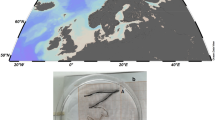Abstract
This paper presents results of field and laboratory work on one component of population structure ofIridaea splendens (Setchellet Gardner) Papenfuss (Gigartinaceae, Rhodophyta), the seasonal change in abundance of the gametophyte life-history stage. Investigations of this genus by others (using a variety of sampling and identification techniques) have shown a seasonal gametophyte dominance, sporophyte dominance, or some combination of these two. Gametophyte stages ofIridaea splendens produce kappa carrageenan and tetrasporophyte stages lambda carrageenan; a chemical colorimetric test using resorcinol can be used to identify these stages regardless of the presence of reproductive structures. In this paper we report on the proportion of gametophytes determined both by this chemical test and by the presence of reproductive structures, and on one possible determinant of the seasonal change in dominance. Analysis of field samples using the resorcinol test showed that from June–August the gametophyte stage predominates and from December–February the tetrasporaphyte stage is most common, both in reproductive and non-reproductive thalli (the latter tested as three size classes). Examination of reproductive structures gave similar results. One factor suggested in the literatures as a possible determinant of the haploid/diploid ratio is apomeiosis (in the formation of the tetraspores); our results show this to be unimportant in the Vancouver Harbor populations.
Similar content being viewed by others
References
Abbott IA (1980) Seasonal population biology of some carrageenophytes and agarophytes. In Abbott IA, Foster MS, Eklund LF (eds), Pacific Seaweed Aquaculture. California Sea Grant College Program Publication 45–53.
Adams RW (1979) A study of growth, reproduction, and competition in populations ofIridaea cordata (Turner) Bory (Rhodophyta) in Georgia Strait, B.C. M. Sc. Thesis, The University of Victoria, Victoria, British Columbia, Canada, i–xi, 1–227.
Ang P, De Wreede R (1990) Matrix models for algal life history stages. Mar. Ecol. Prog. Ser. (in press).
Ang P, De Wreede R, Shaughnessy F, Dyck L (1990) A simulation model for anIridaea splendens population in Vancouver, Canada. Paper presented at the XIIIth International Seaweed Symposium, Vancouver, Canada. August, 1989 (Abstract).
Bell G (1982) The Masterpiece of Nature: The Evolution and Genetics of Sexuality. Univ. of California Press, Berkeley, U.S.A., 1–635.
Caswell H (1989) Matrix Population Models: Construction, Analysis, and Interpretation. Sinauer Associates, Sunderland, Maine, 1–350.
Craigie JS, Leigh C. (1978) Carrageenans and agars. In Hellebust JA, Craigie JS (eds), Handbook of Phycological Methods. Physiological and Biochemical Methods. Cambridge University Press, Cambridge, U.S.A., 109–131.
De Wreede RE, Klinger T (1988) Reproductive strategies in algae. In Lovett Doust J, Lovett Doust L (eds), Plant Reproductive Ecology. Oxford University Press, New York, 267–284.
Dyck L, De Wreede RE, Garbary D (1985) Life history phases inIridaea cordata (Gigartinaceae): relative abundance and distribution from British Columbia to California. Jap. J. Phycol. 33: 225–232.
Garbary DJ, De Wreede RE (1988) Life history phases in natural populations of Gigartinaceae (Rhodophyta): Quantification using resorcinol. In Lobban CS, Chapman DJ, Kremer BP (eds), Experimental Phycology: A Laboratory Manual. Cambridge University Press, Cambridge, 174–178.
Ghiselin MT (1988) The evolution of sex: a history of competing points of view. In Michod RE, Levin BR (eds), The Evolution of Sex. Sinauer Associates Inc., Sunderland, USA, 7–23.
Hannach G, Santelices B (1985) Ecological differences between the isomorphic reproductive phases of two species ofIridaea (Rhodophyta: Gigartinales). Mar. Ecol. Prog. Ser. 22: 291–303.
Hansen JE (1977) Ecology and natural history ofIridaea cordata (Gigartinales, Rhodophyta) growth. J. Phycol. 13: 395–402.
Hansen JE, Doyle WT (1976) Ecology and natural history ofIridaea cordata (Rhodophyta; Gigartinaceae): population structure. J. Phycol. 12: 273–278.
May G (1986) Life history variations in a predominantly gametophytic population ofIridaea cordata (Gigartinaceae, Rhodophyta). J. Phycol. 22: 448–455.
McCandless EL, Craigie JS, Hansen JE (1975) Carrageenans in the gametophytic and sporophytic stages ofIridaea cordata (Gigartinaceae). Can. J. Bot. 53: 2315–2318.
McCandless EL, West JA, Guiry MD (1983) Carrageenan patterns in the Gigartinaceae. Biochem. Syst. Ecol. 11: 175–182.
McLachlan J (1973) Growth media-marine. In Stein JT (ed.), Handbook of Phycological Methods. Cambridge University Press, Cambridge, U.S.A., 25–52.
Nelson WA, De Wreede R (1989) Reproductive phenology ofAnalipus japonicus (Harv.) Wynne (Phaeophyta) in the eastern North Pacific. Jap. J. Phycol. (Sorui) 37: 53–56.
Raper JR, Flexer AS (1970) The road to diploidy with emphasis on a detour. In Charles HP, Knight BCJG (eds), Organization and Control in Prokaryotic and Eukaryotic Cells, 20th Symp. of the Society for General Microbiology. Cambridge University Press, Cambridge, 401–432.
Santelices R, Norambuena R (1987) A harvesting strategy forIridaea laminarioides in central Chile. In Ragan MA, Bird CJ (eds), Twelfth International Seaweed Symposium. Dordrecht, Netherlands, 329–333.
Scagel RF, Garbary DJ, Golden L, Hawkes MW, Lindstrom SC, Oliveira JC, Widdowson TB (1989) A Synopsis of the Benthic Marine Algae of British Columbia, S.E. Alaska, Washington and Oregon. Phycological Contribution #3, Department of Botany, the University of British Columbia, Vancouver, B.C., Canadan, 1–532.
Silva PC (1979) The benthic algal flora of central San Francisco Bay. In Conomos TH (ed.), San Francisco Bay, the Urbanized Estuary. Pacific Division, AAAS, San Francisco, 287–345.
Sokal RR, Rohlf FJ (1981) Biometry. W.H. Freeman & Co., San Francisco, 1–859.
van der Meer JP, Guiry MD, Bird CJ (1983) Sporogenesis in male plants ofChondrus crispus (Rhodophyta, Gigartinales). Can. J. Bot. 61: 2261–2268.
Westermeier R, Rivera PJ, Chacana M, Gomez I (1987) Biological bases for management ofIridaea laminarioides Bory in southern Chile. In Ragan MA, Bird CJ (eds), Twelfth International Seaweed Symposium. Dordrecht, Netherlands, 313–328.
Zar JH (1984) Biostatistical Analysis, 2. Prentice Hall, Inc., Englewood Cliffs, N.J., 1–718.
Author information
Authors and Affiliations
Additional information
Presented at the XIIIth International Seaweed Symposium, University of British Columbia, Vancouver, Canada, August 1989.
Rights and permissions
About this article
Cite this article
De Wreede, R.E., Green, L.G. Patterns of gametophyte dominance ofIridaea splendens(Rhodophyta) in Vancouver Harbour, Vancouver, British Columbia, Canada. J Appl Phycol 2, 27–34 (1990). https://doi.org/10.1007/BF02179766
Received:
Revised:
Accepted:
Issue Date:
DOI: https://doi.org/10.1007/BF02179766




